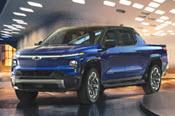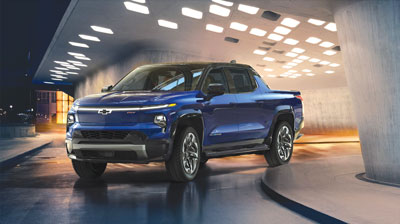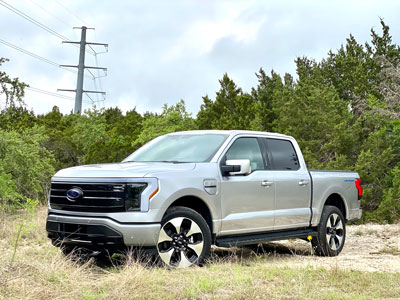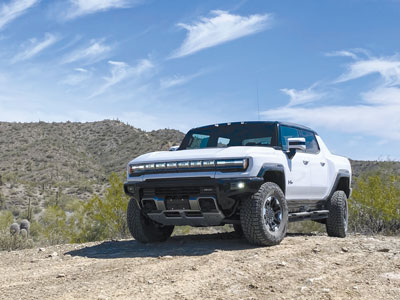
Production expands to offer more zero-emission trucks for potential farm use.
By Colleen Halpenny
Electric versions of compact cars and some small utility vehicles have been on the market, and with increased presence, for a number of years. And as you’ve likely noticed, some manufacturers are beginning to unveil their first electric pickup truck models.
We recently researched how current electric options compare, and we also looked at the likelihood they would become essential machines on the farm and in the lives of Ontario farm families.
While there are some exciting and attractive new pickups arriving soon at your local dealerships, we are not convinced zero-emission options are ready to replace your heavy-duty work trucks.
But maybe soon.
Chevrolet Silverado EV
“Currently we are taking pre-orders, and expect to see the first Silverado EVs available on the lots in about 18 months,” shares Mark Cullen, president of Barry Cullen Chevrolet in Guelph.

Much of the interest right now is coming from drivers looking to be more environmentally conscious, says Cullen, who expects pricing to be comparable to traditional fuel-burning trucks – allowing EVs to be competitive in the marketplace.
Cargo space is not limited, with a bed of five feet 11 inches being standard. And without a traditional engine, drivers will get the convenience of a trunk – something new for any pickup owner.
Over 660 hp with Wide Open Watts Mode will take you from zero to 95 kilometres per hour in under 4.5 seconds.
The Silverado EV 2025 models expect to haul up to 10,000 pounds of capacity, with future models increasing to 20,000 pounds of towing. With an estimated range of 640 kilometres on a full charge, Cullen says that the truck itself won’t be the radical change, but rather the routine of repowering.
“With the Ultium battery, the truck is capable of charging faster. So, each 10-minute charge delivers a 100-kilometre range. As many people are most likely to charge at home, Chevrolet has developed a program called ‘Charged by Chevrolet’ to assist with installing a Level 2 charger at your home,” says Cullen.
The Level 2 chargers, in comparison with traditional electrical outlet plugs, will cut in half a typical charging period. The program will offer $1,500 toward upgrading a charging station.
“General Motors are also making a commitment to increase the number of charging stations across the country. They anticipate the needs of those who travel, and know that making these fast ports accessible is key.
“Rural Canadians should not be concerned that they won’t find a spot to charge,” assures Cullen.
Ford F-150 Lightning
As one of Canada’s best-selling trucks for over 50 years, the F-Series is breaking new ground to meet the growing demand for a gas-free pickup.

“There’s a lot of discussion, interest, and calls coming in about the Lightning trucks right now,” says Graham McNabb, sales representative with Lakeland Ford Sales in Prince Albert, Sask.
“They’re in high demand. It’s adapting the location and the buyers to the truck that is going to take some time.”
The F-150 Lightning delivers 580 hp with 775 pounds per foot of torque with the available extended-range battery. The battery has an estimated range of 515 kilometres to maximize travel between charging.
Anticipating the needs of buyers, the F-150 Lightning hauls up to 10,000 pounds and offers a Max Tow Package to make hauling easier. With seating for five with impressive payload capacity, it also estimates remaining range with increased intelligence so you’re never on empty.
“Making the towing in our first electric models comparable with the traditional F-150 series was important because we need to deliver what drivers expect and need to have in their lives. Improved access to Stage 2 and Stage 3 chargers will make these a top feature on the roads in the coming years,” says McNabb.
GMC Hummer EV
While it’s been an uncommon sight on farms in the past, the Hummer EV offers likely the most luxurious features for an electric truck or SUV.

With early models coming later this year, will we be seeing more of these “supertrucks” on rural roads?
“We have a large pre-order list for the truck, but I do notice that those who have ordered are already driving Denali or ZR2 trucks. So I’m unlikely to see it used in the field, but it definitely hits the mark for a truck you want to enjoy your time in,” says Peter Lawton, executive sales representative with Myers Cadillac CHEV Buick GMC of Ottawa.
Available with 1,000 hp and 11,500 pounds per foot of torque, the Hummer EV pickup also has the added option of Extract Mode to lift the whole vehicle approximately six inches, and a crabwalk option to drive diagonally.
With more charging stations coming to rural Canada, the 560-kilometre range will ensure drivers can spend less time repowering, and more time enjoying the drive.
Improved ground clearance is made possible by specially engineered 35-inch Goodyear Wrangler All Territory tires for an optimal balance of on- and off-road performance. Hummer EV is also 37-inch OD tire-capable.
Taking advantage of the new front truck capacity, Lawton says drivers will enjoy the ability to carry more without sacrificing the comfort in the cab.
“As they work to improve adaptability to Canadian conditions, buyers should continue to monitor updates from the GM website to stay in the know and explore the interior features. This is the vehicle you get to treat yourself with,” says Lawton.
Bottom line
Many farmers have been on the fence, or openly skeptical, during the recent development of electric pickups.
As these vehicles literally hit the road, some Canadian producers still have questions. For example, how will EVs handle the heavy loads a work truck has to handle? And will high torque demands deplete batteries, requiring constant recharging?
But still, regulations require that at least 20 per cent of new vehicles sold in Canada will be zero-emission by 2026, at least 60 per cent by 2030, and 100 per cent by 2035.
While there is much potential government discussion on regulations going forward, Cullen knows that farmers still need to get the job done.
“Technology is always moving forward. Think back on how big your first calculator or cell phone was. In the electric vehicle space that is advancing faster than we ever imagined.
“What we thought were great achievements two years ago, have already been surpassed. The breadth of availability is growing exponentially to offer more options.
“But we also need people to keep working their jobs. And right now, we can’t see the electric options replacing those heavy-duty trucks that are needed to haul trailers and equipment.
“These electric pickups will be an option for farmers who are looking at replacing a traditional half-ton, or make a more sustainable choice for your off-farm vehicles,” says Cullen. BF



Post new comment